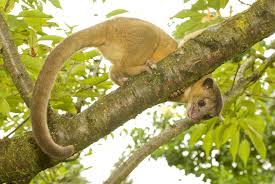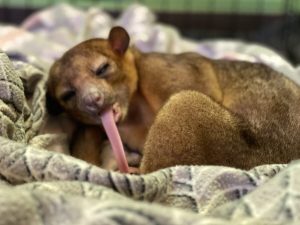Podcast: Play in new window | Download (Duration: 7:14 — 8.4MB)
Thanks to Lincoln for suggesting this week’s subject, the kinkajou!
Further reading:
Early Primates Groomed with Claws
Not actually a monkey:

Not actually a bear [photo taken from this site]:

Show transcript:
Welcome to Strange Animals Podcast. I’m your host, Kate Shaw.
This week we’re going to learn about an animal suggested by Lincoln. It’s the kinkajou, an adorable but weird little animal from Central and South America.
In episode 302 we talked about the coatimundi and the olingo, and both those animals are closely related to the kinkajou. So is the raccoon. But the kinkajou is the only member of its own genus that probably started evolving separately from its closest relations around 22 million years ago.
When the kinkajou was first described scientifically in the late 18th century, it was considered to be a type of lemur, which is a primate. At first glance, the kinkajou really does look like a primate in many ways. It’s arboreal, meaning it lives in trees, and it has a long prehensile tail. Its head is rounded with a short snout, and its large eyes are forward-pointing. Its ears are also low on the sides of its head. All these features resemble features common in primates, but the kinkajou isn’t related to primates at all. Eventually biologists figured it out and it was reclassified.
You can tell the kinkajou isn’t a primate if you know what to look for. It has fur on the bottoms of its feet, while primates always have bare skin on the bottoms of our feet and hands. Its fingers also all have long claws, whereas all primates have fingernails. The only exception is what’s called a toilet claw that some primates retain, including lemurs, where one toe has a claw instead of a nail that the animal uses to groom its fur. But no modern primates have claws on all their digits.
The kinkajou is covered with thick, plush fur that keeps it warm in cold weather. Some populations live in high elevations where it can get cold at night, and since it’s a nocturnal animal it needs to stay warm while it’s out looking for food. It’s yellowish-brown in color but some of its hairs are tipped with darker brown. Even though the darker hairs are mixed in with the lighter ones and the kinkajou doesn’t actually have a pattern of darker spots, the dark hairs absorb more light than the lighter hairs and can make it look spotted in low light. This helps it blend in with the dappled shade in the trees where it lives.
The kinkajou and its close relations make up the family Procyonidae, which is classified in the order Carnivora. Carnivora means “meat-eaters,” but Procyonids are all omnivores that don’t eat a lot of meat. The kinkajou mostly eats fruit, and its favorite fruit is the fig. It also eats other plant parts, insects, and honey, but it mostly just wants lots of yummy ripe figs. (Same.)
The kinkajou lives in family groups, typically one female and her young offspring, a dominant male, and a subordinate male. During the day the family members sleep in a tree hollow or in a tangle of branches that give them plenty of shade. When it starts getting dark, the kinkajous wake up and go out looking for food. Sometimes the family forages together but more often they split up and forage on their own. When there’s a lot of food available in one place, like a bunch of fig trees, a whole lot of kinkajous may gather to eat and play together.
Because it spends just about all its life in the treetops, the kinkajou is well adapted to arboreal life. It can turn its hind feet around backwards to help it climb headfirst down a tree trunk, which is another trait it shares with the raccoon. Other animals have evolved the same ability, though, even ones that aren’t closely related to the kinkajou.
The kinkajou’s prehensile tail is strong and thick, and it often hangs from its tail to eat. It’s not a very large or heavy animal, only 10 lbs in weight at the most, or 4.6 kg, and usually less than half that. Because it’s only about the size of a cat, it can climb onto thin branches to pick fruit. It also has an extremely flexible spine, so flexible that it can twist its head and shoulders 180 degrees from its pelvis.
A female kinkajou usually only has one baby at a time, sometimes two. She mostly takes care of the baby herself, although occasionally its dads will play with the baby or help it collect fruit. The baby stays with the family even after it’s able to care for itself, until it grows old enough that it leaves to find its own territory. The kinkajou can live a long time, 30 or 40 years, partly because it doesn’t have very many predators in its treetop habitat.
One other interesting detail about the kinkajou is its tongue. It has a surprisingly long tongue that it can stick far out of its mouth to lick up insects like ants. It also likes nectar and honey, so its long tongue helps it gather both. The kinkajou is sometimes called the honey bear since it likes honey and its fur is the color of honey, but it’s not related to bears any more than it’s related to primates.
One local name for the kinkajou translates to “bear-monkey,” and that’s honestly probably the best name for it–as long as we can remember that it’s not a bear and not a monkey!
You can find Strange Animals Podcast at strangeanimalspodcast.blubrry.net. That’s blueberry without any E’s. If you have questions, comments, or suggestions for future episodes, email us at strangeanimalspodcast@gmail.com. If you like the podcast and want to help us out, leave us a rating and review on Apple Podcasts or Podchaser, or just tell a friend. We also have a Patreon at patreon.com/strangeanimalspodcast if you’d like to support us for as little as one dollar a month and get monthly bonus episodes.
Thanks for listening!